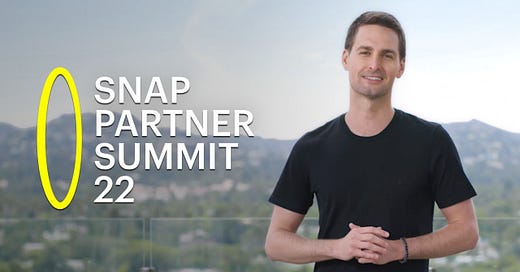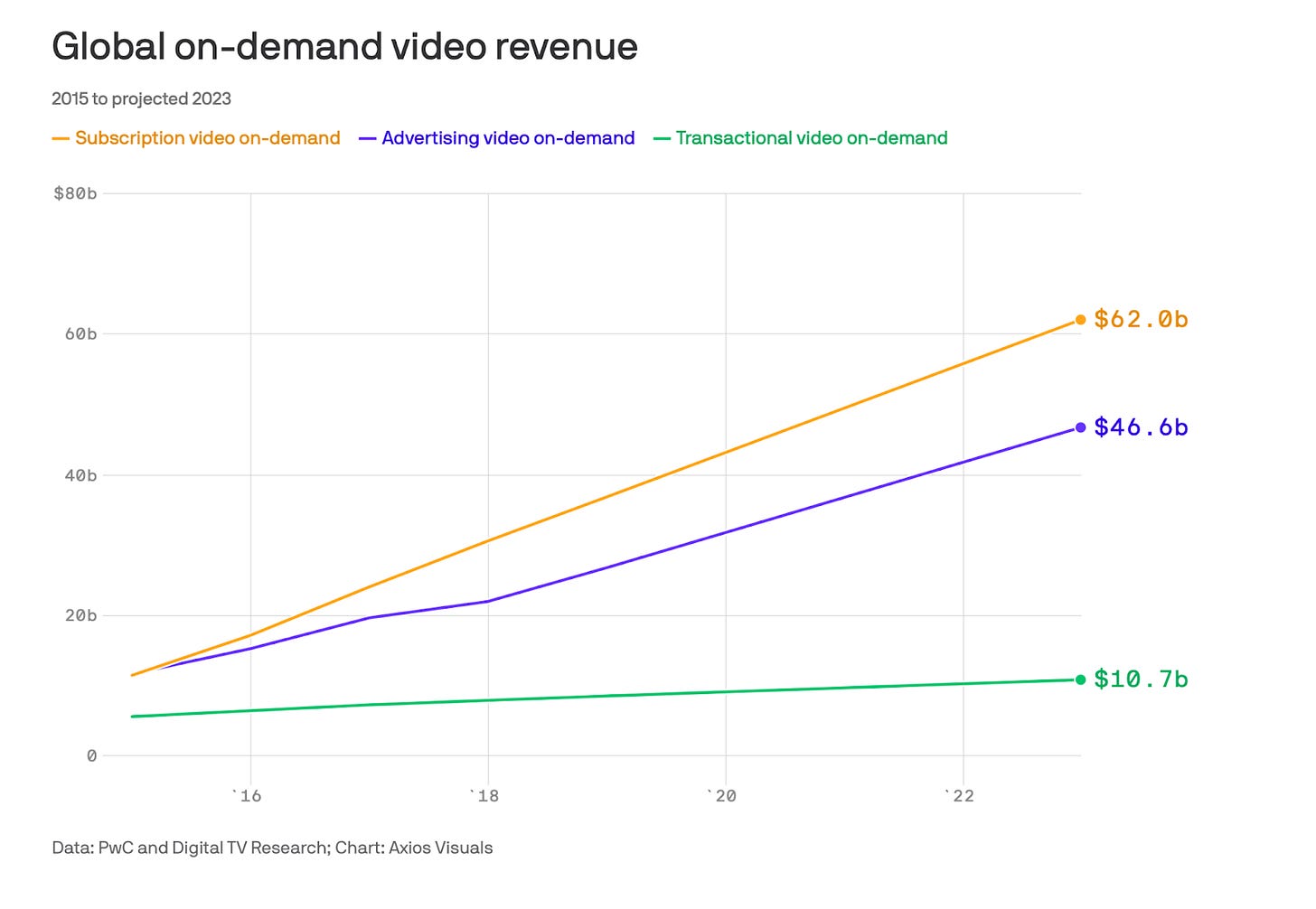Lab Weekly - 04/29/2022
Snap Partner Summit 2022 Recap; Plus, our analysis on the latest news and stats from Twitter, Meta, YouTube, and more
Hi there, apologies for the slight delay in delivering this edition of Lab Weekly – we had to wait to get the Snapchat event recap ready, and that event took place yesterday afternoon! Besides the written recap, keep an eye out for a new Floor 9 podcast episode dropping on Monday to hear more of our hot takes on Snapchat’s announcements. The usual round of news analysis and eye-opening stats to follow. Let’s dive in!
Snap Partner Summit Recap: What Brands Need to Know
Snap Inc. kicked off the spring tech conference season on Thursday with a live-streamed presentation. During the hour-long keynote, the company unveiled a new crop of creative tools on Snapchat, shared some impressive stats on its users, and launched the long-speculated consumer-facing camera drone. There are a lot of noteworthy announcements to unpack, but the key throughline across all of Snap’s announcements is the company’s unwavering commitment to its strategic plan of becoming the designated AR platform for the next generation of creators.
In case you missed it…
The Metaverse ≠ Web3: What Brands Need To Know
The metaverse discourse is being muddled by crypto startups and getting lost amid web3 hype, but innovation-forward brands should not lose sight on why it truly matters
Elon Musk vs. Twitter: What Brand Marketers Can Learn from It
The unfolding saga of Elon Musk vs. Twitter offers a fascinating case study of the “cults of personality” that are gaining traction in today’s consumer culture. Regardless of the outcome, the billionaire provocateur's half-joking entry into activism investment will have lasting consequences for Twitter.
The Future of Video Games
The gaming industry is growing rapidly with an outsized cultural influence, yet the shifts towards cloud gaming and the metaverse bring new challenges and opportunities. Here’s what brand marketers need to know about the key trends in the gaming industry and how we think they may aid or hinder brand opportunities in the future.
Elon Musk To Buy Twitter For $44 Billion [CNN Business]
Well, he did it. By making an offer that Twitter board could not refuse, aka a 38% premium over its share price, Elon Musk has beat the “poison pill” bylaws that Twitter threatened to invoke and is set to purchase the social network for $44 billion. While the deal is far from being finalized,
it has already polarized Twitter employees, users, and regulators over the implications on free speech. In particular, European regulators already raised the warning flags over potentially relaxing practices of content moderation.
The smart guess at the moment is that Elon Musk, being the busy billionaire that he is, will likely get bored with Twitter and hand it off to a new executive team that is less mercurial than he is to manage. And many have pointed out that, with the way this takeover deal is structured, Musk himself is actually on the hook for Twitter’s financial performance, lest he risk losing a ton of his own money. Elon already shared that he plans to monetize tweets, including a way to monetize tweets that go viral or include important information. He also suggested the idea of charging a fee when third-party websites quote or embed tweets from verified accounts. All of these, of course, should be taken at face value until they materialize.
We agree with our sibling agency MAGNA’s take on what brands advertising on Twitter should do at the moment, which is nothing but closely monitoring how the situation develops. For now, we expect the new owner of Twitter to continue upholding the platform’s commitment to media responsibility and brand safety on its platform.
Related: Elon Musk sells $8.5 billion of Tesla shares after deal to buy Twitter {WSJ]; Twitter reports user bump, revenue miss for Q1, days after accepting Musk’s takeover bid [CNBC]; EU and UK warn Elon Musk must comply or face sanctions [The Guardian]
Facebook Is Opening A “Meta Store” in California [ARS Technica]
While the irony of driving consumers to a single, physical location to sample “metaverse-related” products is not lost on many, this new concept store does signal Meta’s evolving strategy towards its hardware business. Facebook has not exactly had a robust distribution strategy when it comes to hardware products, but with its Oculus VR headsets and the camera-equipped sunglasses born out of its Ray-Ban partnership, it is the right time for the company to rethink that.
This concept store will launch on Meta’s corporate campus, which should be a safe and cost-effective way for the company to figure out exactly what kind of in-person try-on experiences it needs to sell its AR and VR hardware, and leveraging this retail touchpoint to better explain the concept to regular consumers. Some 60% of US adults either strongly or somewhat agreed with the statement “I don’t understand the purpose of the metaverse,” according to a January 2022 survey from Protocol and The Harris Poll. However, nearly as many agreed that the metaverse will soon become as popular as traditional social media platforms.
Related: Meta’s Oculus Quest 2 has shipped 10 million units, according to Qualcomm [The Verge]; Facebook shares spike on better-than-expected quarterly earnings [CNBC]; Meta burned $2.96 billion on Reality Labs last quarter [Game Developer]
YouTube Starting to Run Ads on Shorts, Its TikTok Clone [Bloomberg]
Nearly two years after launching Shorts to compete against the rise of TikTok, YouTube has finally rolled out its first batch of ad products to its short-form video, starting with, of course, app-install ads and other tried-and-true direct response units. Google reported that the Shorts are now amassing 30 billion daily views on average, but it has also seen a drop in direct response ads in its first-quarter earnings report. Therefore, this entry to monetizing Shorts is a no-brainer.
As the OG platform for digital video, YouTube has long touted its mutually beneficial relationship with creators. But short video monetization is more complex than simply sharing ad revenue, since there’s no easy way to directly monetize short-form video clips with mid and pre-roll ads. The main solution that many platforms have settled on so far has been setting aside dedicated creator funding pools, from which creators can then earn an allocation of fund share based on the performance of their Shorts clips. But that’s not a perfect solution either, with variable payouts and shifting incentives getting called out by some top TikTok creators, It will be interesting to see if YouTube can figure out a robust and fair revenue-sharing model that works for short video creators.
Related: Why TikTok stars are criticizing its creator fund [Engadget]; TikTok was the top app by worldwide downloads in Q1 2022 [TechCrunch]; TikTok looms large in tech earnings from Google, Facebook, Amazon [CNBC]
Digital fashion brand RTFKT Studios has launched a brand new NFT called Nike CyrptoKicks, and people have been buying them for astounding price tags. The NFT's, or non-fungible tokens, were launched on NFT marketplace OpenSea, and are selling for as much as $100,000 and more. Over the weekend, RTFKT saw people buying its 20,000 NFT sneakers for anywhere between $7,500 and $9,000 (2.5 to 3 ETH).
According to Shopify’s internal numbers, interactions with products featuring 3D/AR content had a 94% higher conversion rate than those without it. Adding video lifts conversion rates 60% over buyers interacting with images alone.
Source: Axios
If you find our insights valuable and would like to have a deeper conversation on technology and media innovations, or need to sound smarter in a client meeting or a pitch, please feel free to reach out to our Group Director Josh Mallalieu!
If you liked this edition of Lab Weekly by IPG Media Lab, why not share it?










